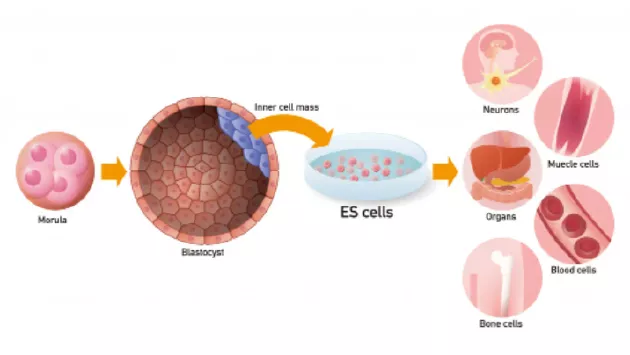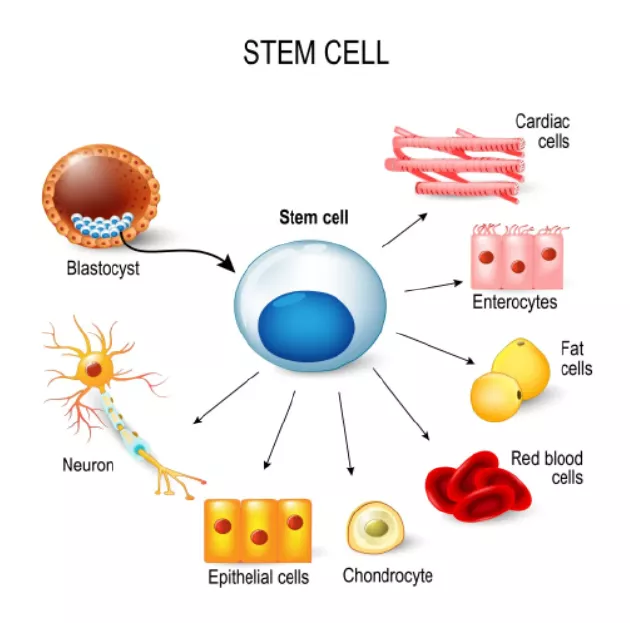The plot of being born as an old man and dying as a baby will only appear in the novel. However, scientists have found a way to achieve similar miracles at the cellular level. By manipulating certain genes in cells, researchers can turn fully mature cells into "young" stem cells.
In the movie the curious case of Benjamin Button, the protagonist named Benjamin Button was born like an old man and was abandoned in the nursing home as a monster, but no one thought that he turned his age upside down, lived younger and younger, and finally died as a baby. Such a scenario is completely fictional, but at the Salk Institute in California, scientists have found a similar process of reversing aging.

How do stem cells differentiate into many different types of cells and eventually form our body
Aging, in fact, is a naturally occurring process with the continuous accumulation of cell damage over time. Reactive oxygen species (ROS) play an important role in the process of aging. In addition, environmental pollution and bad lifestyle have also accelerated the degradation of our body and spirit. Cataracts, skin wrinkles, hypertension, diabetes and dementia are some of the characteristics of aging. So can we reverse or mitigate these age-related signs?
Recently, scientists have begun to develop "cell regeneration technology" (CRT) to reduce the incidence rate of age-related diseases. The technique involves expressing Yamanaka factors in senescent cells that reset epigenetic markers to patterns found in young animals.
To be exact, reversing aging does not make a 60 year old look like a 20-year-old, but makes a 60 year old feel as healthy as a 20-year-old in terms of physical function.

Left: regeneration of Hydra. Hydra has regenerative stem cells, making it close to immortality. Right: regeneration of planaria
Understanding pluripotency
First, we need to make individual cells of the body "young". In other words, the cells of our body should have the ability to regenerate and form new and younger cells. Pluripotent stem cells have this ability.
Pluripotent stem cells can divide and differentiate into many cell types. They have two unique properties: one is self-renewal; The second is the ability to differentiate into cells with different functions.
There are two types of pluripotent stem cells: embryonic stem cells and induced pluripotent stem cells (IPSC). Embryonic stem cells are derived from the inner cell mass of blastocyst and can differentiate into ectoderm, mesoderm and endoderm. Induced pluripotent stem cells are pluripotent stem cells reverse programmed from mammalian somatic cells.
Under the influence of specific signals of proteins called transcription factors, these artificially induced pluripotent stem cells can differentiate into specialized cells with fixed functions. For example, transcription factors such as snail, MITF and c-kit can differentiate pluripotent stem cells into melanocytes (a kind of skin cells).

How can induced pluripotent stem cells (IPSC) transform into many different types of cells
Is there an immortal life
Creatures such as scroll, Hydra and starfish are the closest creatures to immortality that have been found so far. They have a large number of pluripotent stem cells, which can continuously differentiate to replace damaged or aging cells. Therefore, in humans, pluripotent stem cells may indeed differentiate and replace aging cells. "Rejuvenation" may not be a dream.

Induced pluripotent stem cells (IPSC) differentiate into a variety of cell types, including nerve cells, muscle cells and adipocytes
Mountain factors and induced pluripotency
Stem cells have been used in stem cell therapy. Japanese stem cell scientist Shinya Yamanaka and his team discovered induced pluripotent stem cells (IPSC) in 2006, opening a new field of stem cell therapy.
IPSC transfers Oct-4, SOX4, KLF4 and c-myc transcription factor genes (collectively referred to as oskm gene) into adult cells through lentivirus vector and transforms them into pluripotent stem cells similar to embryonic stem cells. Like embryonic stem cells, these reprogrammed cells also have the ability of self-renewal. In theory, they can differentiate into any cell type and develop into any organ and tissue of adults. In the process of induction, mature specific cells essentially "reverse aging" and turn into pluripotent stem cells.
Through IPSC technology, human beings have pluripotent stem cells that can be used for treatment for the first time in history. Induced pluripotent stem cells are also the only pluripotent stem cells except embryonic stem cells.
From embryonic cells to differentiated cells
An important "creed" for the fate of cells is that embryonic cells will become differentiated cells after the expression of some genes. Yamanaka's process of reverse programming differentiated cells into induced pluripotent stem cells challenged this creed and completely changed stem cell research.
Before Yamanaka used transcription factors to create miracles, the transformation of pluripotent cells into differentiated cells was a one-way street. With the help of "Yamanaka factor", he transformed differentiated cells (fibroblasts of adult mice) into iPS cells, thus eliminating their cell fate. Under the influence of some factors, these cells can differentiate into specific cell types (muscle cells, nerve cells or bone cells, etc.).
Further: reverse aging
With inducible pluripotent stem cells, it is possible to reset the cell program with appropriate signals. This raises a question: with the help of transcription factors, can aging cells in human body become young and healthy again.
Scientists from the Salk Institute have successfully "reset" aging cells to young cells. So, can intermittent expression of genes related to embryonic state (Oct4, KLF4, Sox2) reverse the characteristics of aging? Scientists believe that aging is not one-way, as long as the right signal is sent, aging can also be reversed.
The researchers speculate that cell reprogramming in aging animals will make them younger. The only bottleneck is that although cell regeneration is simple to operate in the laboratory, it may have completely different performance within the whole organism. In addition, induced pluripotent stem cells will continue to reproduce, so it may not be beneficial to introduce them directly into aging animals. Inducing Yamanaka factor in a short time may be more conducive to reversing aging.
Mouse models of premature aging (a disease of premature aging) are often used to study the reversal of aging. Through the short-term induction of Oct4, Sox-2 and KLF4 genes (OSK gene) in premature aging mice, it was found that the mice expressing OSK gene were younger than the control mice, the cardiovascular and pulmonary functions were improved, and the life span was prolonged by 30%. OSK gene is expressed in short pulses in aging mice, and scientists have also observed signs of reversing aging in normal aging mice. In other words, the quality of life of aging mice was improved by cell reprogramming of Yamanaka factor.